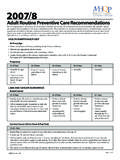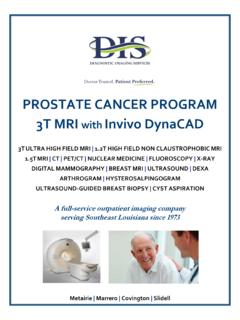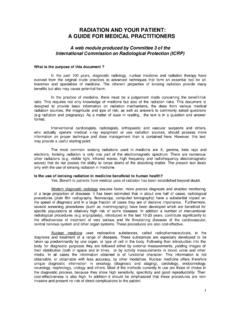Transcription of ACR Practice Guideline for the Performance of …
1 The American College of Radiology, with more than 30,000 members, is the principal organization of radiologists, radiation oncologists, and clinical medical physicists in the United States. The College is a nonprofit professional society whose primary purposes are to advance the science of radiology, improve radiologic services to the patient, study the socioeconomic aspects of the Practice of radiology, and encourage continuing education for radiologists, radiation oncologists, medical physicists, and persons practicing in allied professional fields. The American College of Radiology will periodically define new Practice guidelines and technical standards for radiologic Practice to help advance the science of radiology and to improve the quality of service to patients throughout the United States.
2 Existing Practice guidelines and technical standards will be reviewed for revision or renewal, as appropriate, on their fifth anniversary or sooner, if indicated. Each Practice Guideline and technical standard, representing a policy statement by the College, has undergone a thorough consensus process in which it has been subjected to extensive review, requiring the approval of the Commission on Quality and Safety as well as the ACR Board of Chancellors, the ACR Council Steering Committee, and the ACR Council. The Practice guidelines and technical standards recognize that the safe and effective use of diagnostic and therapeutic radiology requires specific training, skills, and techniques, as described in each document .
3 Reproduction or modification of the published Practice Guideline and technical standard by those entities not providing these services is not authorized. 2008 (Res. 24)* ACR Practice Guideline FOR THE Performance OF SCREENING AND DIAGNOSTIC mammography PREAMBLE These guidelines are an educational tool designed to assist practitioners in providing appropriate radiologic care for patients. They are not inflexible rules or requirements of Practice and are not intended, nor should they be used, to establish a legal standard of care. For these reasons and those set forth below, the American College of Radiology cautions against the use of these guidelines in litigation in which the clinical decisions of a practitioner are called into question.
4 The ultimate judgment regarding the propriety of any specific procedure or course of action must be made by the physician or medical physicist in light of all the circumstances presented. Thus, an approach that differs from the guidelines, standing alone, does not necessarily imply that the approach was below the standard of care. To the contrary, a conscientious practitioner may responsibly adopt a course of action different from that set forth in the guidelines when, in the reasonable judgment of the practitioner, such course of action is indicated by the condition of the patient, limitations of available resources, or advances in knowledge or technology subsequent to publication of the guidelines.
5 However, a practitioner who employs an approach substantially different from these guidelines is advised to document in the patient record information sufficient to explain the approach taken. The Practice of medicine involves not only the science, but also the art of dealing with the prevention, diagnosis, alleviation, and treatment of disease. The variety and complexity of human conditions make it impossible to always reach the most appropriate diagnosis or to predict with certainty a particular response to treatment.
6 Therefore, it should be recognized that adherence to these guidelines will not assure an accurate diagnosis or a successful outcome. All that should be expected is that the practitioner will follow a reasonable course of action based on current knowledge, available resources, and the needs of the patient to deliver effective and safe medical care. The sole purpose of these guidelines is to assist practitioners in achieving this objective. I. INTRODUCTION Periodic mammography screening of age-appropriate asymptomatic women is currently the only imaging modality that has been shown by the preponderance of data to reduce breast cancer mortality [1-3].
7 Unlike screening mammography , diagnostic mammography is intended to provide specific analytic evaluation of patients with clinical or screen-detected abnormalities. A screening mammogram is an X-ray examination of the breast of an asymptomatic woman performed in order to detect breast cancer before it becomes clinically evident. A diagnostic mammogram is an X-ray examination of the breast of a patient who has signs or symptoms of breast disease or who has a possible abnormality detected on screening mammography or by other imaging technique [4].
8 It is essential that all mammography be performed and interpreted with the highest quality possible [5]. Key points to be considered are the criteria for credentialing professionals (radiologists, radiologic technologists, and medical physicists), equipment specifications, monitoring and maintenance schedules, standards for image quality, standardized image evaluation procedures, meticulous record keeping, and periodic review of data for outcomes of the mammography services. All mammography must be performed in concordance with the mammography Quality Standards Act (MQSA) final rule as published by ACR Practice Guideline Screening and Diagnostic mammography / 1 the Food and Drug Administration (FDA) [6].
9 Nothing in this document should be construed to contradict those regulations. II. DEFINITIONS A. Screening mammography Screening mammography is a radiological examination performed to detect unsuspected breast cancer in asymptomatic women. Standard views are obtained, and thus the interpreting physician does not need to be present at the facility to monitor the examination when the patient is imaged. B. Diagnostic mammography Diagnostic mammography is a radiographic examination performed to evaluate patients who have signs and/or symptoms of breast disease, imaging findings of concern, or prior imaging findings requiring specific follow-up.
10 Diagnostic mammography requires direct III. GOALS The goal of all mammography is the detection and evaluation of breast cancer and other breast diseases. The goal of diagnostic mammography is to obtain information that leads to specific interpretive conclusions and/or further diagnostic and management recommendations or courses of action. The patient s history, symptoms, and signs, the reported findings on physical examination, and results of any prior mammography will focus the diagnostic breast evaluation.





